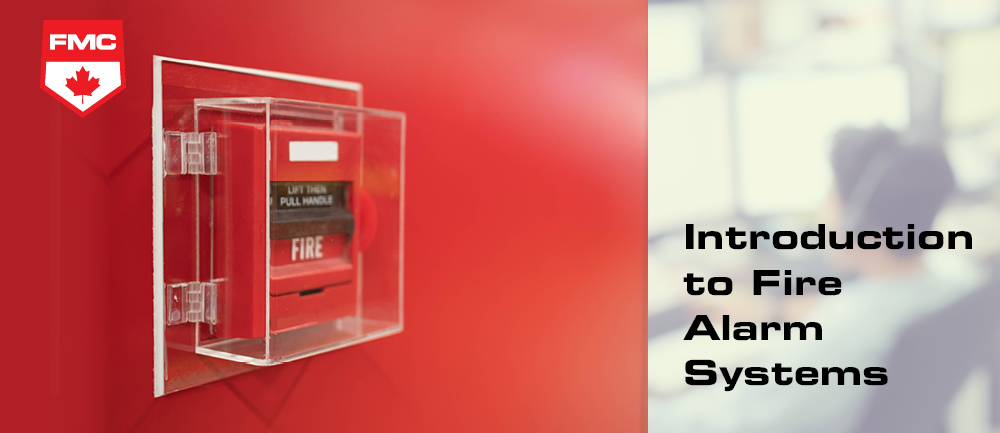Introduction to Fire Alarm Systems


Protecting your building from a fire is of utmost importance for many property owners and managers. When deciding on the type of fire alarm system for your building, it’s important to understand how the system operates.
This introduction to fire alarm systems helps to define what a fire alarm system is, the elements that make up the system, outlines the two different types of fire alarm systems, and touches on a few of the benefits of having these systems within your building.
What Is a Fire Alarm System?
Your fire alarm system consists of different devices such as heat and/or smoke detectors, and pull stations, which signal to a control panel that a fire has been detected and then alerts building occupants to evacuate through audible and/or visual signalling devices.
Components of a Fire Alarm System
A fire alarm system consists of many different input and output devices, including:
- Control Panel – the control panel is the brains of a fire alarm system, which monitors all the system’s inputs. The control panel is also responsible for controlling the actions of the system’s output actions, and relays information to the notification devices.
- Power Supply – the power supply of your fire alarm system requires both a primary and back up power supply.
- Initiating Devices – these devices are responsible for transmitting a signal to the control panel signaling that there is a possible fire. There are two types:
- Automatic – automatic devices consist of detectors that measure or identify the presence of smoke, heat, CO2, and flames.
- Manual – these devices need a person to activate them, such as a pull station.
- Notification Appliances – notification appliances are made up of visual and audible devices that are used to alert building occupants of a fire.
- Building Safety Components – these components manage certain aspects of the building safety infrastructure and are meant to assist people in exiting the building.
- Other – there are often other aspects of a fire alarm system including fire doors, sprinklers, elevator recalls, among others. It is also increasingly common to have a building’s fire alarm system be integrated with the building’s security system or other smart building technologies.
Types of Fire Alarm Systems
The two main types of fire alarm systems are conventional and addressable. Both systems communicate with devices in a similar manner; however, they are unique in how they are connected.
- Conventional – In a conventional fire alarm system, the control panel is connected to each device using a separate wire and are typically set up on zones. Utilizing zones helps to narrow down the location of a potential fire. For example, if your facility has six floors and each floor is set up as a zone, the fire department can determine on which floor the fire is located based on the activated zone.
- Addressable – An addressable fire alarm system gives a unique address to each device that is on the system. This allows you to identify the precise location of the activated device and relay that information to the fire department. In this system, all the devices are connected on one wire that is looped into the control panel. As a result, even if one section is damaged, the system is still able to relay information to the control panel utilizing the other end of the loop. Addressable fire alarm systems provide a lot of flexibility and are often used for large facilities.
Benefits of Fire Alarm Systems
There are many advantages to installing a fire alarm system in your building, here are just a few:
- Warning – fire alarm systems provide audible and visual alerts to give building occupants notice of a potential danger, and prompt them to evacuate the building.
- Fire Alarm Monitoring – when used in collaboration with your fire alarm system, fire alarm monitoring ensures that the fire department is notified of a fire at your facility.
- Early Detection – a properly functioning fire alarm system makes it possible to quickly detect a fire. When used along side fire alarm monitoring, this allows the fire department to respond quickly, which assists in mitigating building damage or loss of life.
- Insurance Discounts – A fire alarm system in your building can be helpful in secure pricing discounts on building insurance.
Learn More
Contact Us
 For over 30 years, Fire Monitoring of Canada (FMC) has been a leader in the monitoring of fire alarm and intrusion alarm systems. If you would like to learn more about fire alarm systems, call us at 1 888 789 FIRE (3473), email fminfo@fire-monitoring.com, or fill out the contact form below.
For over 30 years, Fire Monitoring of Canada (FMC) has been a leader in the monitoring of fire alarm and intrusion alarm systems. If you would like to learn more about fire alarm systems, call us at 1 888 789 FIRE (3473), email fminfo@fire-monitoring.com, or fill out the contact form below.